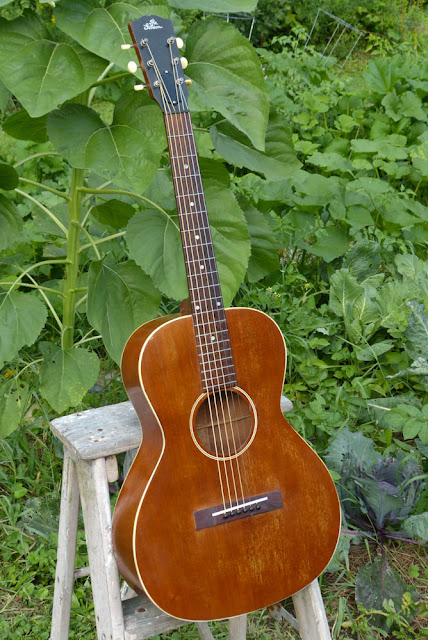1930 Gibson L-0 Flattop 12-Fret Guitar
What a honey this one is! It's built light as a feather with bracing as delicate as a late-20s/early-30s Martin and boy does it sound good. It's had a bit of a rough life in its past but after a bit of work over here it's primed and ready to go. These all-mahogany L-0s don't show up as frequently as we'd all like and so their airy, full, and woody-sweet voices aren't heard as often as the more crisp L-00s. What makes this guitar even better is that it's a 12-fret and so all that drive is put into a perfect spot on the soundboard. It's all-yum, folks.
The factory order number places this at 1930 when this particular version of the L-0 was introduced. It's even recorded in Spann's Guide. It was intended as a more basic version of the L-00 (spruce top of the same build) but depending on your style of music, a mahogany top can be a nice upgrade over spruce. It's a superb fingerpicker and is also very well-suited to old-timey backup styles with a flatpick as well.
The factory order number places this at 1930 when this particular version of the L-0 was introduced. It's even recorded in Spann's Guide. It was intended as a more basic version of the L-00 (spruce top of the same build) but depending on your style of music, a mahogany top can be a nice upgrade over spruce. It's a superb fingerpicker and is also very well-suited to old-timey backup styles with a flatpick as well.
So, on to the work! In days past this guitar had a bunch of old work done to it. It came to me with the neck already reset, a new bridge installed, lots of seam repair work and crack cleats installed, and an either refinished or topcoated-and-buffed finish on the whole body. The neck looks like it has mostly original (if oversprayed here-n-there) finish, though.
It also came to me with the above-soundhole main brace detached, a replacement bridge that was far too bulky and awkward, frets needing a light level/dress, and a new saddle and full setup and cleaning desperately needed. The work has all been done to make it ship-shape and in good health and it plays perfectly (1/16" treble, 3/32" bass action at the 12th fret) with a functioning, straight, truss-rodded neck, and good intonation. The fretboard extension dips slightly down past the 12th fret -- which was due to the old repairman not wedging it up after regluing the neck. I left it as-is because I never play past the 15th on a 12-fret neck, anyhow, and I doubt anyone else does, too -- minus a slide!
The truss rod cover is new and the tuners are StewMac Golden Age repros. They're a good replacement for the originals and function very well. The nut is the original ebony one.
This has a neck profile that's more akin to the 40s C-shaped Gibsons than the 30s V-shaped ones. It's "medium" in heft but handles very easily and has a 1 3/4" width. It's similar to a late-20s L-1 that's in the shop right now as well.
Pearl dots in a radiused Brazilian rosewood board... with those vintage Gibson "micro-frets." They used some pretty thin stock back then but they're very tough stuff and hold up very well. They're almost full-height and only needed a light level/dress to get them all spot-on.
Scale length is standard 24 3/4" Gibson style.
There's a bit of compression warp (ie, sinkage) around the soundhole but that's kind of standard on a lightly-braced guitar like this. No worries -- stable.
The replacement bridge was unfortunately very awkward and bulky when it came in. I cut it back down a bunch and brought it back to standard Gibson-style height and profile from the time. If I'd made the bridge I would've put the pin-holes a little farther back (Gibson-style) rather than the Martin-ish placement, here, but that's a very small gripe. The rosewood used was good stock and I fit it with some ebony pins to match-up more closely with the black pins that would've been original.
The second part of the work on the bridge was to cut the saddle slot deeper and longer and that let me fit a nice, new, long compensated bone saddle in.
Here you can see the extra saddle height and profile from the side. There's a tiny bit of belly on the guitar when it's tuned up -- but like a 30s Martin of similar bracing spec -- you have to expect that. It doesn't hurt the tone or the guitar at all.
I do have this strung up with 50w-11 rather than 54w-12 strings. The top is so thin and the bracing so light that I figured it didn't need anything more -- and it doesn't.
Do you see the bits of mahogany-strip fill behind the binding? That's prevalent in a few edges on the top and back... but really not obvious.
I added a new ebony endpin as well.
It comes with a hard, arched-lid TKL/Canadian case. Good stuff.
Here I'm trying to show the repaired cracks in the top. There's two to the treble side and one to the bass side of the fretboard extension.
The soundhole also has this little crunched-in area that I glued back up and filled-in.
Here are two small ones behind the bridge....
...and the back has two tiny hairlines right at the waist on either side.
All these cracks are stable and good to go.



























Comments